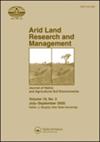Forest degradation and short-term seasonal exclosure effects on biotic and abiotic factors linked to rangeland rehabilitation in semiarid Chaco, Argentina
IF 1.6
4区 农林科学
Q3 ENVIRONMENTAL SCIENCES
引用次数: 1
Abstract
Abstract In semiarid Chaco, wet season grazing exclosures allow a rapid grass recovery in mature and secondary forest patches, but not in the most degraded patches dominated by shrublands. In order to understand the causes of their dissimilar rehabilitation dynamics, we analyzed the effects of the forest-patch type (mature forest = MF, secondary forest = SF, and shrubland = S) and 4-year seasonal exclosures (vs continuous grazing) on biotic and abiotic factors (vegetation structure, incident radiation, grass seed bank, litter and soil traits) that could affect grass recovery. We found that vegetation structure, through determining litter quantity, controlled soil chemical traits. As forest degradation level increased, litter mass (MF = 6260, SF = 5410, S = 1220 kg DM/ha), total soil organic matter (MF = 5.1%, SF = 4.1%, S = 3.5%) and nitrogen (MF = 0.25%, SF = 0.22%, S = 0.18%) decreased, and the incident radiation at soil level rose (MF = 28%, SF = 41%, S = 52%). After 4 years of seasonal grazing rest, we found reduced soil bulk density (from 1.13 to 1.07 and 1.07 to 1 g/cm3) and increased total porosity (from 57 to 60 and 60 to 62%) at 0–10 and 10–30 cm depth, respectively, in all forest patch types. Exclosure also increased soil seed bank density (from 28 to 251 grass seeds/m2) both in the forests (with grass) and in the shrublands (even before grass recovery), which would receive seeds from the adjacent forest patches, which coexist in the same landscape matrix. Our results suggest that the low tree cover, litter, and soil chemical traits related to lower availability of water and nutrient in shrublands, could hamper grass recovery in recently established exclosures. However, improvements in the grass seed bank and soil physical traits related to higher water infiltration could favor its late recovery, which is triggered by an extremely wet cycle after several years of the seasonal exclosure. Exclosure is a promising management strategy for degraded areas involving intermingled patches of forests and shrublands.阿根廷查科半干旱地区森林退化和短期季节性封育对牧场恢复相关生物和非生物因素的影响
在半干旱的查科地区,湿季放牧可以使成熟和次生林斑块的草地迅速恢复,但在以灌丛为主的退化最严重的斑块中则不能。为了了解其不同恢复动态的原因,我们分析了森林斑块类型(成熟林= MF,次生林= SF,灌丛= S)和4年季节性封育(与连续放牧相比)对影响草地恢复的生物和非生物因子(植被结构、辐射、草种子库、凋落物和土壤性状)的影响。植被结构通过控制凋落物数量,控制土壤化学性状。随着森林退化程度的增加,凋落物质量(MF = 6260, SF = 5410, S = 1220 kg DM/ha)、土壤总有机质(MF = 5.1%, SF = 4.1%, S = 3.5%)和氮素(MF = 0.25%, SF = 0.22%, S = 0.18%)减少,土壤入射辐射(MF = 28%, SF = 41%, S = 52%)增加。经过4年的季节性放牧休息,我们发现所有森林斑块类型在0-10 cm和10-30 cm深度的土壤容重分别从1.13降低到1.07和1.07降低到1 g/cm3,总孔隙度分别从57增加到60和60增加到62%。封育还增加了森林(有草)和灌丛(甚至在草地恢复之前)的土壤种子库密度(从28个增加到251个/m2),这些种子库将从相邻的森林斑块中接收种子,它们共存于同一景观基质中。我们的研究结果表明,低树木覆盖度、凋落物和土壤化学特征与低水分和养分有效性有关,可能阻碍最近建立的封地中草的恢复。然而,高水分入渗对草种子库和土壤物理性状的改善有利于其后期恢复,这是由数年季节性封育后的极湿循环引发的。对于森林和灌丛混杂的退化地区,围封是一种很有前途的管理策略。
本文章由计算机程序翻译,如有差异,请以英文原文为准。
求助全文
约1分钟内获得全文
求助全文
来源期刊

Arid Land Research and Management
环境科学-环境科学
CiteScore
3.80
自引率
7.10%
发文量
23
审稿时长
9 months
期刊介绍:
Arid Land Research and Management, a cooperating journal of the International Union of Soil Sciences , is a common outlet and a valuable source of information for fundamental and applied research on soils affected by aridity. This journal covers land ecology, including flora and fauna, as well as soil chemistry, biology, physics, and other edaphic aspects. The journal emphasizes recovery of degraded lands and practical, appropriate uses of soils. Reports of biotechnological applications to land use and recovery are included. Full papers and short notes, as well as review articles and book and meeting reviews are published.
 求助内容:
求助内容: 应助结果提醒方式:
应助结果提醒方式:


